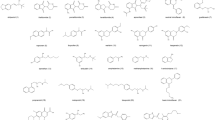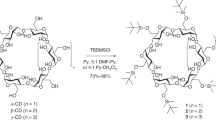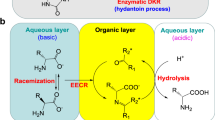Abstract
We describe a protocol for the synthesis of mono-6A-(1-butyl-3-imidazolium)-6A-deoxy-β-cyclodextrin chloride (BIMCD), a cationic, water-soluble cyclodextrin used in the chiral separation of amino acids and anionic pharmaceuticals by capillary electrophoresis. Starting from commercially available chemicals, BIMCD is synthesized in five steps. The first step involves a nucleophilic substitution between p-toluenesulfonyl chloride and imidazole to afford 1-(p-toluenesulfonyl)imidazole (A). In the second step, a nucleophilic substitution between β-cyclodextrin and A affords mono-6A-(p-toluenesulfonyl)-6A-deoxy-β-cyclodextrin (B). In the third step, a nucleophilic substitution between 1-bromobutane and imidazole affords 1-butylimidazole (C). In the fourth step, a nucleophilic addition between A and C affords BIMCD tosylate. In the final step, anion exchange using an ion-exchange resin yields BIMCD as a highly water-soluble solid. Each step takes up to 2 d, including the time required for product purification. The overall protocol requires approximately 6 d.
This is a preview of subscription content, access via your institution
Access options
Subscribe to this journal
Receive 12 print issues and online access
$259.00 per year
only $21.58 per issue
Buy this article
- Purchase on Springer Link
- Instant access to full article PDF
Prices may be subject to local taxes which are calculated during checkout



Similar content being viewed by others
References
Ahuja, S Chiral Separations by Chromatography (ACS, New York, USA, 2000).
Ikai, T., Yamamoto, C., Kamigaito, M. & Okamoto, Y. Immobilized polysaccharide derivatives: chiral packing materials for efficient HPLC resolution. Chem. Rec. 7, 91–103 (2007).
Agranat, I., Caner, H. & Cadwell, J. Putting chirality to work: the strategy of chiral switches. Nat. Rev. Drug Discov. 1, 753–768 (2002).
Ward, T.J. Chiral separation. Anal. Chem. 78, 3947–3956 (2006).
de Boer, T., de Zeeuw, R.A., de Jong, G.J. & Ensing, K. Recent innovations in the use of charged cyclodextrins in capillary electrophoresis for chiral separations in pharmaceutical analysis. Electrophoresis 21, 3220–3239 (2000).
Nair, U.B. & Armstrong, D.W. Evaluation of two amine-functionalized cyclodextrins as chiral selectors in CE: comparisons to vancomycin. Microchem. J. 57, 199–217 (1997).
Chankvetadze, B. & Blaschke, G. Enantioseparations in capillary electromigration techniques: recent developments and future trends. J. Chromatogr. A 906, 309–363 (2001).
Zhu, W. & Vigh, G. A family of single-isomer, sulfated γ-cyclodextrin chiral resolving agents for capillary electrophoresis: octa(6-o-sulfo)-γ-cyclodextrin. Electrophoresis 24, 130–138 (2003).
Kirby, D.M. & Vigh, G. Heptakis(2-o-methyl-3,6-di-o-sulfo)-β-cyclodextrin: a single-isomer, 14-sulfated–β-cyclodextrin for use as a chiral resolving agent in capillary electrophoresis. Electrophoresis 22, 3152–3162 (2001).
Iványi, R., Jicsinszky, L., Juvancz, Z., Roos, N., Otta, K. & Szejtli, J. Influence of (hydroxy)alkylamino substituents on enantioseparation ability of single-isomer amino-β-cyclodextrin derivatives in chiral capillary electrophoresis. Electrophoresis 25, 2675–2686 (2004).
Lee, D. & Shamsi, S.A. Chiral separation of anionic and neutral compounds using a hepta-substituted cationic β-cyclodextrin as a chiral selector in capillary electrophoresis. Electrophoresis 23, 1314–1319 (2002).
Iványi, R., Jicsinszky, L. & Juvancz, Z. Chiral separation of pyrethroic acids with single isomer permethyl monoamino β-cyclodextrin selector. Electrophoresis 22, 3232–3241 (2001).
Budanova, N., Shapovalova, E., Lopatin, S., Varlamov, V. & Shpigun, O. Heptakis(6-amino-6-deoxy)-β-cyclodextrin as a chiral selector for the separation of anionic analyte enantiomers by capillary electrophoresis. Electrophoresis 25, 2795–2802 (2004).
Tang, W.H., Ong, T.T., Muderawan, I.W., Ng, S.C. & Chan, H.S.O. Synthesis and applications of single-isomer 6-mono(alkylimidazolium)-β-cyclodextrins as chiral selectors in chiral capillary electrophoresis. Electrophoresis 26, 3839–3848 (2005).
Tang, W.H., Muderawan, I.W., Ong, T.T. & Ng, S.C. Facile synthesis and enantioseparation performance of positively charged single-isomers of α- and γ-cyclodextrin. Tetrahedron Asymmetry 18, 1548–1553 (2007).
Tang, W.H., Muderawan, I.W., Ong, T.T., Ng, S.C. & Chan, H.S.O. Synthesis and application of mono-6-ammonium-6-deoxy-β-cyclodextrin chloride as chiral selector for capillary electrophoresis. J. Chromatogr. A 1094, 187–191 (2005).
Tang, W.H., Muderawan, I.W., Ong, T.T. & Ng, S.C. Enantioseparation of acidic enantiomers in capillary electrophoresis using a novel single-isomer positively charged β-cyclodextrin: mono-6A-N-pentylammonium-6A-deoxy-β-cyclodextrin chloride. J. Chromatogr. A 1091, 152–157 (2005).
Tang, W.H., Ong, T.T., Muderawan, I.W. & Ng, S.C. Effect of alkylimidazolium substituents on enantioseparation ability of single-isomer alkylimidazolium-β-cyclodextrin derivatives in capillary electrophoresis. Anal. Chim. Acta 585, 227–233 (2007).
Tang, W.H., Ong, T.T. & Ng, S.C. Chiral separation of dansyl amino acids in capillary electrophoresis using mono-(3-methyl-imidazolium)-β-cyclodextrin chloride as selector. J. Sep. Sci. 30, 1343–1349 (2007).
Acknowledgements
We are grateful to the National University of Singapore and the Institute of Chemical and Engineering Sciences, Singapore, for their financial support.
Author information
Authors and Affiliations
Corresponding authors
Rights and permissions
About this article
Cite this article
Tang, W., Ng, SC. Synthesis of cationic single-isomer cyclodextrins for the chiral separation of amino acids and anionic pharmaceuticals. Nat Protoc 2, 3195–3200 (2007). https://doi.org/10.1038/nprot.2007.479
Published:
Issue Date:
DOI: https://doi.org/10.1038/nprot.2007.479
This article is cited by
-
Mirror-image cyclodextrins
Nature Synthesis (2024)
-
Preparation of cyclodextrin chiral stationary phases by organic soluble catalytic 'click' chemistry
Nature Protocols (2011)
-
Facile synthesis of mono-6-amino-6-deoxy-α-, β-, γ-cyclodextrin hydrochlorides for molecular recognition, chiral separation and drug delivery
Nature Protocols (2008)
Comments
By submitting a comment you agree to abide by our Terms and Community Guidelines. If you find something abusive or that does not comply with our terms or guidelines please flag it as inappropriate.



